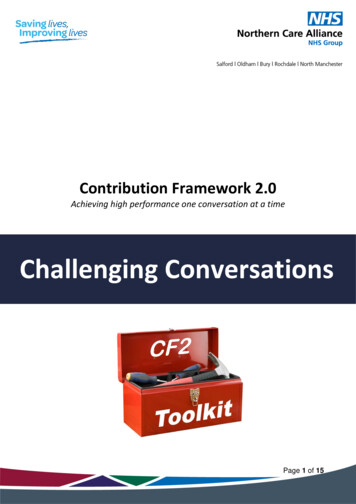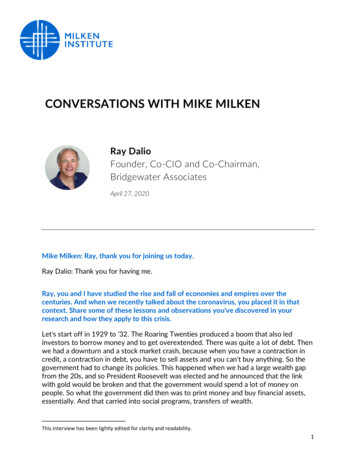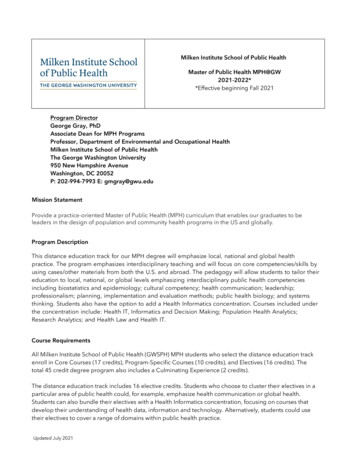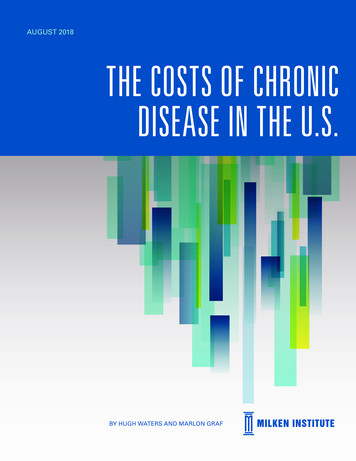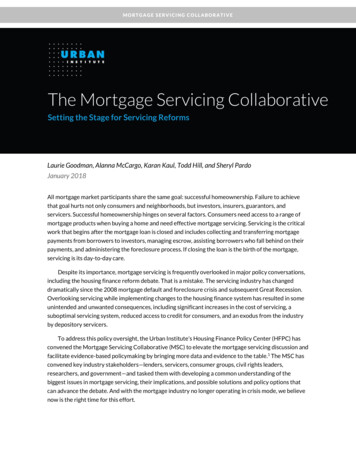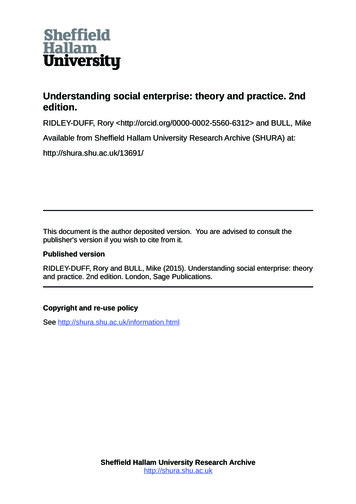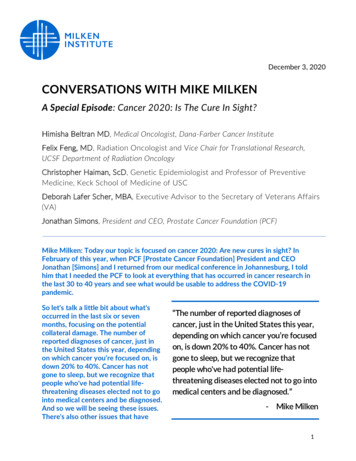
Transcription
December 3, 2020CONVERSATIONS WITH MIKE MILKENA Special Episode: Cancer 2020: Is The Cure In Sight?Himisha Beltran MD, Medical Oncologist, Dana-Farber Cancer InstituteFelix Feng, MD, Radiation Oncologist and Vice Chair for Translational Research,UCSF Department of Radiation OncologyChristopher Haiman, ScD, Genetic Epidemiologist and Professor of PreventiveMedicine, Keck School of Medicine of USCDeborah Lafer Scher, MBA, Executive Advisor to the Secretary of Veterans Affairs(VA)Jonathan Simons, President and CEO, Prostate Cancer Foundation (PCF)Mike Milken: Today our topic is focused on cancer 2020: Are new cures in sight? InFebruary of this year, when PCF [Prostate Cancer Foundation] President and CEOJonathan [Simons] and I returned from our medical conference in Johannesburg, I toldhim that I needed the PCF to look at everything that has occurred in cancer research inthe last 30 to 40 years and see what would be usable to address the COVID-19pandemic.So let's talk a little bit about what'soccurred in the last six or sevenmonths, focusing on the potentialcollateral damage. The number ofreported diagnoses of cancer, just inthe United States this year, dependingon which cancer you’re focused on, isdown 20% to 40%. Cancer has notgone to sleep, but we recognize thatpeople who've had potential lifethreatening diseases elected not to gointo medical centers and be diagnosed.And so we will be seeing these issues.There's also other issues that have“The number of reported diagnoses ofcancer, just in the United States this year,depending on which cancer you’re focusedon, is down 20% to 40%. Cancer has notgone to sleep, but we recognize thatpeople who've had potential lifethreatening diseases elected not to go intomedical centers and be diagnosed.”- Mike Milken1
Conversations with Mike Milken: Cancer 2020: Is The Cure in Sight, November 25, 2020come up and they are, what's happened with medical research and the shutting ofphysical research laboratories during this period of time.But at the same time throughout the world, research has gone on, and once again willchange the face of cancer treatment and cancer outcomes for the better. I'd like to giveyou just a few statistics here before I turn it over to Jonathan: the first sequencing ofthe human genome took more than 10 years, led by Francis Collins, and cost of billionsof dollars. Now the cost of sequencingyour genome costs about 200“In the era of COVID, switching from awholesale; one fifth of an MRI and lessthan certain chest X-rays. So the cost oftreatment that requires a patient tocome to the hospital every day for eight sequencing and determining what yourissues are is now available for almostweeks versus one that can be done inevery single person. This hasdramatically changed research as wefive treatments, not only is thisknow it: computers a million timesimproving convenience and quality offaster; data storage costs down onelife for patients, but it's also reducingbillionth, have allowed us to do thingsthe risk that they catch COVID-19 from we could have never achieved before.being in the hospital.”Once we sequence, and once we- Felix Feng understand the mutations, wediscovered that cancer, a particularmutation is not related to any one areain your body. And more than 70 cancers have mutations similar to prostate cancer, andJonathan will talk about it. The solutions that we are finding in prostate cancer havealready shown to have applications in other forms of cancer.But one of the things I want to stress on this panel is that many of the potentialsolutions and success that we are going to have in treating COVID-19 lie in work thatwe have done over the years at the Prostate Cancer Foundation to try to reduce thedeath rate and ultimately eliminate cancer as a cause of death.Jonathan will set the stage for a discovery and analysis that was done at the ProstateCancer Foundation in 1999 [based] on the fact that using ADT drugs – androgendeprivation therapy – results quite possibly in the prevention of the [COVID-19] virusfrom going to your lungs. A clinical trial was begun a couple of months ago on this issueto try to identify these drugs, which are often generic, and ones that are fast-acting, butonly lasts for 30 to 40 days and can quite possibly prevent the movement to your lungsof this virus and serious side effects.There are more than 70 anti-viral anti-cytokine vaccine and other products out of themore than 500 that are on the tracker at FasterCures, the sister organization of the2
Conversations with Mike Milken: Cancer 2020: Is The Cure in Sight, November 25, 2020Prostate Cancer Foundation. And with that, Jonathan, I'd like to turn it over to you.Thank you for joining us today.Jonathan Simons: Thanks Mike. As Mike said so elegantly, the road tocuring COVID runs right through lots and lots of cancer research. DebraScher will talk a little bit about the VA [Veterans Administration] asprobably the least-publicized and most-important platform right now forending COVID-19 deaths in terms of clinical trials, built on a platform ofhow Dr. [Himisha] Beltran and Dr. [Felix] Fang and I take care of cancerpatients. Literally the new precision care models for oncology are being applied in realtime to treating COVID. The revolution that the human genome has brought and themomentum that it's brought to cancer care and understanding how genes work and thenhow the software, called epigenomics, works from Dr. Fang, who's the vice chair ofradiation oncology at the University of California, San Francisco as a physician scientist.Understanding genes has gotten deep into the software of what makes them actuallyactive or quiet or turns them up or turns them down.And Chris Haiman has taken the human genome and human genetics and done work inpolygenics, or polygenic risk. Himisha Beltran from the Dana Farber and Harvard MedicalSchool, a PCF Young Investigator, has gone on to become a world leader in precisiononcology. So Misha, what's precision medicine for prostate cancer? Why is it theparadigm for taking care of over 73 other forms of human cancer? Why is ittransformational? And by 2025 what will cancer care even look like with all of this?Himisha Beltran: Thank you, Jonathan. Good morning, everyone. It'sreally wonderful to be here. This is really a topic that is near and dearto my heart because even in the last 10 years, doing research in thisarea and taking care of patients, this has really transformed the way wethink about cancer and the way we care for individuals.I thought it would be good to just kind of step back and think about the term precisionmedicine, because this is something we hear about a lot when we think about research,healthcare delivery. But it's really an approach that’s quite simple. It's can we moreprecisely deliver healthcare or medicines to patients by matching the best therapy withthe right patient? And by doing this, we can deliver better outcomes.And this is extending beyond our traditional factors. Traditionally we think about thingslike the physical exam or laboratory values or radiology pathology. Now we're taking itone step further recognizing that every individual is different, and by studying themolecular features of people and their cancers, we can make more precise orpersonalized decisions when treating people diagnosed with cancer. A lot of precisionmedicine has focused on genetics, or alterations in the DNA, because we've known formany years that cancer is a genetic disease. And as Bert Vogelstein, one of our pioneersin cancer genomics said in the 90s, these DNA mutations or alterations can drive cellular3
Conversations with Mike Milken: Cancer 2020: Is The Cure in Sight, November 25, 2020multiplication, increases in tumor size, disorganization and malignancy, the hallmarks ofcancer. But despite knowing this for so many years, it really wasn't until recently that wehad the capability to actually do this in real time for our patients that we're treating inthe clinic.And the reason for this is it's really complicated. There are billions of letters in the DNA.Each person, we're generating massive amounts of data. And then we expand thisthrough hundreds or thousands of people, and we really required big-data scientists,computational tools to able to have clinicians like me interpret this. And we can nowstart to map out patterns of DNAalterations within a cancer cell by“There are billions of letters in the DNA.sequencing the genome. And thenwe can start to interpret this andEach person, we're generating massivefigure out what is in the cancer. Butamounts of data. And then we expandalso can we learn, where did thatthis through hundreds or thousands ofcancer come from? Where is it goingsimilar, to a subway map?people, and we really required big-datascientists, computational tools to able toI was thinking about all theintersecting pathways that occurhave clinicians like me interpret this.”within a cancer cell, and this is- Himisha Beltranallowing us to develop ways tointervene and treat cancer. Andthanks to the Prostate Cancer Foundation, there have been over thousands of genomesalready sequenced, and this has really led to changes in the way we practice and the waywe treat individuals with prostate cancer with targeted drugs.Recently the FDA approved a class of medication called PARP inhibitors – two drugs,Olaparib and Rucaparib – for a select subgroup of patients with prostate cancer basedon the mutations found in the cancer DNA. And this has made precision oncology areality for every prostate cancer patient.Jonathan Simons: But a key thing is you have to have your biopsy sequenced, right,Misha? The precision comes in having the DNA read to match the right drug or the righttreatment.Himisha Beltran: Yeah. And I think one of the challenges is that as we're sequencingmore genomes in cancer and especially in prostate cancer, we focus a lot on the commonalterations because we think those are the ones that are driving the cancer, and can wedevelop drugs for that subset? But in prostate cancer, there are mutations that arepresent, not in everyone, but only a very small fraction of individuals – less than 5% ofpeople, their tumors will harbor one of these mutations. And these have beenparticularly challenging to study because they're not frequent. But we do think that4
Conversations with Mike Milken: Cancer 2020: Is The Cure in Sight, November 25, 2020they're important in conferring response to therapy and may help us develop noveltherapies to target even rare subsets based on the genetic alterations in that cancer.There are patients that achieve exceptional responses to therapy. A patient of mine, a61-year-old with advanced prostate cancer who had developed progression after manylines of therapy, including androgen deprivation therapy, chemotherapy, abiraterone,anti-PSMA therapy on a trial, went on a clinical trial if be Ipilimumab, which you mayknow, is an immunotherapy, and that trial actually went to into Phase Three for prostatecancer. And the trial was not positive,meaning not everyone responded well“We've been thinking about novel waysto Ipilimumab. So this drug did not getto bring treatments to patients based onapproved for prostate cancer.not just their DNA alterations, butintegrating things like RNA and otherbiomarkers, and thinking about treatingpatients without requiring the numbersneeded for a large trial.”But this patient, my patient had anextraordinary response. His PSA wentfrom 72 to 1.4. His cancer nearly wentaway. He had a dramatic improvement insymptoms and he ended up coming off ofthe drug and did not require anyadditional treatment for almost two- Himisha Beltran years. We sequenced his genome and wedid not see anything that we would haveexpected to confer a response to this drug, things that have been associated with responseto immunotherapy in other cancer types; but he did have a lot of these rare alterations.And I think it's really our obligation as a field to really understand exceptional responders,because you can imagine that he's not the only person that would achieve a response likethis to Ipilimumab. But what do we actually do with this? And this is a very early concept,but we've been, as a field, thinking about novel ways to bring treatments to patientsbased on not just their DNA alterations, but integrating things like RNA and otherbiomarkers and thinking about treating patients without requiring the numbers neededfor a large trial, but being able to cast a broad net to identify these long tail alterationsand allocate them to specific drugs in this sort of basket trial sense for prostate cancerspecifically.Jonathan Simons: So this one is interesting because if you're a patient and you have amutation that we could put you in remission for, but only 2% of prostate cancer patientshave that mutation. But 7% of ovarian cancer patients have that, and 9% of breastcancer patients have that, and 14% of colon cancer patients have that – all thosepatients that have the targetable mutation ought to be in a basket and get the drug, notbased on the anatomic, but on the genomic. And that's going to require multicentercollaboration. Deborah Sher will talk about this in the VA as a model, but it's also goingto require patients that are aware that they need to know what their mutations are andwhere they are. We're very excited about this because these other channels of looking5
Conversations with Mike Milken: Cancer 2020: Is The Cure in Sight, November 25, 2020at these tumors also will be reduced to practice in the next five years. We need to makemore drugs very specifically against these new targets, which we know are central tomaking the cancer tick.Himisha Beltran: In five years, I do think that sequencing for every patient, not just withprostate cancer, but all cancers will be reality. We will be using these genomic reports tomake better decisions and is not going to replace what we do today; when we see apatient, we do imaging and get pathology, but this will just help us take it again to amuch more precise or informed level.There will be broader accessibility to genomic expertise, drugs, and trials. And I think alot of this will be due to the fact that telemedicine is really a reality now. This issomething that I predict will stay. It happened overnight with COVID-19 with thepandemic, and I think will help bring people together and be able to help us match drugswith patients in a more effective way. And the next generation of precision assays arecoming. We are moving beyond DNA, and technologies are moving fast. It's not just thegenome now that we are going to be integrating into the clinical decisions in real time forpatients beyond research.Jonathan Simons: Data science is this huge and important area where we think cancerresearch and cancer care are going to lead. But the oncologist you want to take care ofyou is very familiar with how data for caring for a cancer patient works. Thanks Misha.Felix Feng is a very special clinician-scientist and physician-scientist like Misha. He leadsthe UCSF Prostate Cancer Research Program in the laboratories there, but he's [also] apracticing radiation oncologist. I wonder Felix, if you could start with what's happened,let's say in the last 18 months, on how radiation therapy, which is used to treat 47 out of100 cancer patients, can be curative in primary tumors or early cancer. But there's [also]a revolution going on using radiation therapy to treat metastatic disease. So I wonder ifyou could tell us a little bit about that and epigenomics and why, by 2025, this is going tobe a central part as well in taking care of cancer patients?Felix Feng: Absolutely. So the first part you've asked me to talk about is arevolution in radiation oncology across cancers. And, Jonathan, I think theword revolution is quite apt in the sense that if you look at the last two orthree decades of radiation for cancer, we've always thought that radiationshould be used only when cancer patients have what we call localizeddisease, and localized disease means confined to the area of origin; so inprostate cancer, it means prostate cancer confined to the prostate, but gone to thebones or someplace far away from the prostate.But thanks to two very pivotal trials, what we now know is that patients who have alimited amount of metastatic disease, a subset of these can be cured with radiationtherapy. And that's actually paradigm changing, not only in the field of prostate cancer,6
Conversations with Mike Milken: Cancer 2020: Is The Cure in Sight, November 25, 2020but across all of cancer in the sense that now we can use a treatment modality –radiation – that is widely available, we can extend it into a disease space, metastaticdisease, where it really hasn't been used. We can't cure all patients with limitedmetastatic disease, but a subset of them five, seven years after treatment are free ofdisease.The question is, who are those patients? How do we identify them early? Andpotentially, how do we improve upon current cure rates with radiation for metastaticdisease? Radiation has for a very long time been considered what we call a localtreatment. It means that where you aimthe radiation is where the radiation“Radiation has for a very long timeworks; where you don't aim the radiation,been considered a local treatment. Itthe radiation doesn't work. But we mightbe changing that paradigm as well.means that where you aim theThere's something called the abscopalradiation is where the radiation works;effect, and that basically means if youwhere you don't aim the radiation, thetreat one spot of cancer with radiation,another spot that you didn't treat mayradiation doesn't work. But we mightactually respond.be changing that paradigm as well.Now what we see is that, at least for a- Felix Fengvery small proportion of patients,radiation when given withimmunotherapy might work where you don't aim it. These are very, very, interestingtimes, times of kind of great advancement in the context of radiation oncology forcancer. And I would say that thanks to the Prostate Cancer Foundation, researchadvances in prostate cancer are leading the way. Jonathan, do you want me to touchupon anything else regarding radiation before I switch?Jonathan Simons: What is the new form of radiation that's used? It's very different andvery scientific for, with curative intent for illegal metastatic disease. What is that Felix,and why did the cancer cells die?Felix Feng: Sure. And so for, for many decades, when we gave radiation for any cancer,we would give a little bit of radiation every day over the period of many, many weeks.That was what I term “conventional radiation.” But over the last few years, there's beenthe advent of newer forms of radiation that basically all revolve around the principle ofgiving very high-dose radiation to a very small area. And due to advances in how wegive radiation and also advances in how we can keep patients in the exact same spotevery day for a couple of days, we're able to give five to seven times the amount ofradiation to a spot that we were able to do a decade ago. Back 10, 15 years ago, whenwe used to give a little bit of radiation every day for eight weeks or so, and what wehoped was that over the eight weeks together, there'll be enough damage from theradiation to the cancer to kill everything.7
Conversations with Mike Milken: Cancer 2020: Is The Cure in Sight, November 25, 2020But now, within just five treatments we can give the same radiation dose we previouslygave over eight weeks – and that has allowed us to treat metastatic disease. And moreimportantly, in the era of COVID, switching from a treatment that requires a patient tocome to the hospital every day for eight weeks versus one that can be done in fivetreatments, not only is this improving convenience and quality of life for patients byreducing the number of treatments, but it's also reducing the risk that they catchCOVID-19 from being in the hospital. And so all of these advances are benefitingpatients in a multitude of different ways.Jonathan Simons: Thanks, Felix. Teach us about epigenomics.Felix Feng: Absolutely. I wear two hats. I'm a physician on one side like Misha, and alsoI'm a laboratory scientist on the other side, like Misha. And so, what I'm going to do isbriefly talk about the word epigenome. The genome is, as Misha mentioned, focused onDNA, and much of the field of genomics focuses on changes in the sequence of DNA, ormutations, or changes in downstream levels of RNA. DNA is made in RNA. As Mishapointed out, there are multiple layers ofdata we can examine in a cancer cell. And“Men of African ancestry have aone of these different layers is theepigenome.substantially higher genetic risk ofdeveloping prostate cancer. Now thatwe have a better risk-prediction tool,that we have a stronger starting pointfor applying preventative and orscreening measures to those at highrisk, let’s see if we can now begin toreduce disparities and both theincidence and mortality of prostatecancer between different populations.”The epigenome was defined as chemicalcompounds and proteins that combined aDNA to turn genes on and off. Andultimately this may control cellularbiology as much as the genome, the DNAsequence itself.DNA and the architecture of DNA is quitecomplex, in the sense that there arechemical modifications to DNA calledmethylation that can make DNA more orless accessible, and therefore turn genes- Chris Haiman on and off. When you look at clinical trialsfor prostate cancer, precision medicine,much of that precision medicine isfocused on changes in the sequence of the DNA. But I think if you look over the next fiveto 10 years, and you look at opportunities for precision medicine, those opportunities aregoing to arise as we understand additional layers of biology, including the epigenome inprostate cancer and other cancers, as we understand, architecture of DNA andchromosomes and accessibility of genes that leads to certain genes being on versus off.Recently we did a large study where we profiled a component of the epigenome calledmethylation across 100 patients with metastatic prostate cancer, looking at the8
Conversations with Mike Milken: Cancer 2020: Is The Cure in Sight, November 25, 2020metastases themselves. There are methyl groups, which are chemical compounds that arebound to DNA at different spots. And in the hyper-methylated subtype, they actually havemore of these chemical compounds bound to more areas of the DNA. We don't actuallyquite know what it means yet in terms of all the biological processes; that's actually whatwe and others in the laboratory are studying. But what we do know is that patients withthese hyper-methylated subtypes of prostate cancer have different outcomes. And again,all of these patients are patients with metastatic disease, and the hyper-methylatedsubtype, the patients with that actually do better. They have longer survival times oncethey're diagnosed with metastatic prostate cancer than the non-methylated patients. Andso what we've identified through comprehensive methylation profiling of metastaticprostate cancer is that there are different subtypes, and it turns out now that thesedifferent subtypes, these hyper-methylated subtypes have been discovered in othercancers like brain cancers and leukemias and colon cancers as well. We know that theclinical characteristics or clinical outcomes of these hyper-methylated prostate cancers aredifferent, and now we need to study them biologically. We need to understand how totarget them therapeutically. And I just want to point out that all of this research wassponsored by the Prostate Cancer Foundation. Jonathan, I'll turn things back over to you.Jonathan Simons: Thanks Felix. Understanding the activity of these genes is going to beessential and actually designing drugs because we have lots of ideas all of a suddenabout making precision medicines just to stop one line in particular that's making aprostate cancer and a breast cancer cell divide. But also it may be very important tounderstand genes that are turned off that make you normal again. But this way oflooking at a cancer patient's epigenome is going to be also how we care for every formof human cancer. And the work that Felix presented is actually given us really aframework for many other forms of cancer.We've talked about genes in patients with advanced disease, but what if you could findcancers 10 years earlier? Or prevent heart disease? How would you do that? Well, it'salso a big data problem that's been reduced to research practice rather amazingly. ChrisHaiman is one of the world's leaders in population genetics, or how genes work inpopulations for diseases, and is also in an enormous entrepreneur scientific collaborationwith over 100 collaborators around the world to get the numbers up to do this work. So,what's apologenic risk score? Why does it help explain the disproportionate burden ofprostate cancer in African Americans? And what do you think is going to happen toapologenic risk scores in revolutionizing basically how doctors take care of us?Christopher Haiman: Thank you to the Prostate Cancer Foundation forthe invitation to be part of this panel. I think Jonathan and you and Mikehave done a good job to set the stage for some of what I'm going to betalking about: the completion of the human genome sequence andhuman genome sequencing becoming affordable.9
Conversations with Mike Milken: Cancer 2020: Is The Cure in Sight, November 25, 2020We've really learned a tremendous amount over the past decade, about the role ourgenes play in human disease. I'm talking about germline-inherited variants that had beenpassed on through generations. They've been found for many common diseases,including prostate cancer, and here I'm talking about user sequences, changes in ourDNA sequences that exist throughout this, genome associated with risk of developingdisease. But they're appreciably common. They're found in many individuals. And alone,they're not predictive of risk because they only are associated with small increases inrisk. However, in aggregate, a composite of all of these variants is important and can tellyou something very informativeabout someone's overall risk ofdisease. And when we aggregate“[At the VA], we have really built athem together, we put themcommunity of researchers who aretogether in the form of a polygenicbringing best-in-class precision oncologyrisk score where the risk isdetermined for an individual basedto veterans across the country and areon the number of variants that existusing that platform not just for prostateand been discovered for a specificcancer innovation, but today for COVIDdisease or create their frequency inthe population, whether somebodyinnovation as well.”carries it or not, and the associated- Deborah Scherrelative risk for each of thosevariants, which I indicated isrelatively small. However, inaggregate could be associated with an appreciable risk. And so this just highlights thisdistribution of risks that may be observed in a population, with some people having ascore that places them at very high risk of disease, and others having scores that placethem at much lower risk.Jonathan Simons: And Chris, this is looking at hundreds and hundreds of letters of theDNA code right, across the genome.Chris Haiman: Exactly. And so this is a score that can now be calculated for any givendisease or trait and used to assign people to different categories of risk based on theirgenetic makeup. And just one interesting thing that we have noticed when comparingthese polygenic scores across different diseases, such as your heart disease, colorectalcancer, breast cancer, diabetes, and prostate cancer, is the polychronic score for prostatecancer is really quite unique and does a much better job of identifying men at very highrisk of disease.Something that is important to understand about polygenic risk scores: we've noticedwhen comparing them between populations, they're quite different. So for example, menof African ancestry have a substantially higher genetic risk of developing prostate cancercompared to men of European ancestry. I think an important question is now that we10
Conversations with Mike Milken: Cancer 2020: Is The Cure in Sight, November 25, 2020have a better risk-prediction tool, that we have a stronger starting point for applyingpreventative and or screening measures to those at high risk, let’s see if we can nowbegin to reduce disparities and both the incidence and mortality of prostate cancerbetween different populations.Jonathan Simons: This is a very, very important part of the future of population science,for diseases, in terms of where your great, great, great grandparents came from in termsof disease riskChris Haiman: We can do a much better job of telling a man what his lifetime risk isbased on his genetic information. If we incorporate family history, we incorporate otherbiomarkers, I think we'll get even further stratification of a man's risk of developingdisease.So I think the really important question, regarding polygenic risk and polygenic riskscores, is how are we going to use this information clinically to improve health? This isthe big challenge in the field. By 2025 or so, I do expect that the polygenic risk scoreswill be generated and available for a whole host of diseases and will be used byphysicians and patients to guide and inform either changes their lifestyle behaviors toprevent the disease if those are available or for risk stratified, screening. So, disease canbe discovered earlier, before it becomes untreatable. And think this is conceptually verysimilar to what we've already been talking about, about how to treat cancer patient,moving away from this conventional one-size-fits-all approach for more personalizedapproaches to treatment. And I think now it's time to think about how this personalizedapproach can also be applied to prevent
Medicine, Keck School of Medicine of USC Deborah Lafer Scher, MBA, Executive Advisor to the Secretary of Veterans Affairs (VA) Jonathan Simons, President and CEO, Prostate Cancer Foundation (PCF) . Now the cost of sequencing your genome costs about 200 wholesale; one fifth of an MRI and less than certain chest X-rays. So the cost of

